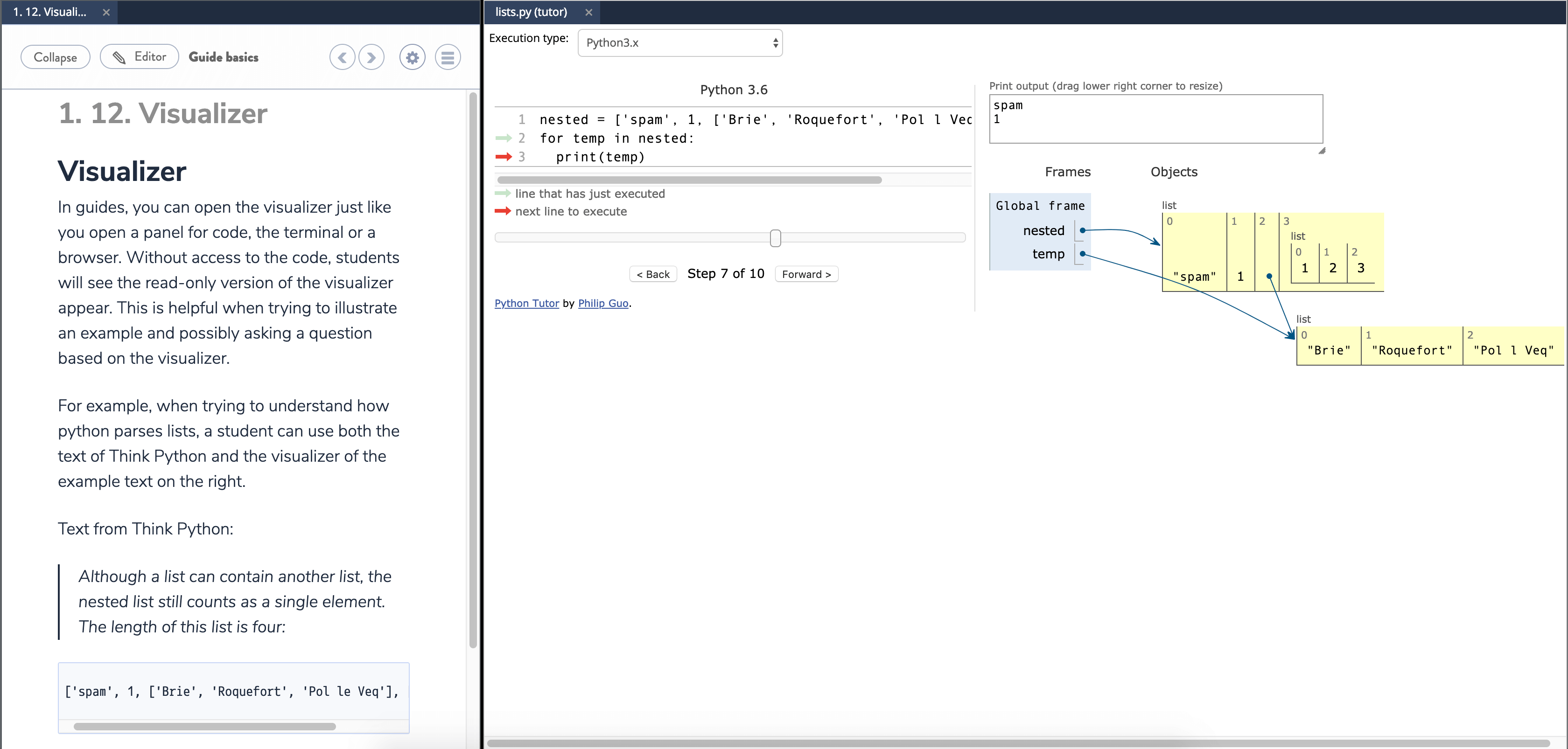Open Tabs
You can automatically perform any of the following actions when a page is shown:
Reconfigure the overall IDE panel layout.
Open files.
Open a url preview including external websites.
Open a terminal window and optionally run a terminal command.
Select lines you wish to highlight within each file.
Open a virtual machine when set up for students.
Opening Files Automatically
Files can be opened automatically to present students with relevant content. You have several options for adding files:
Use the Add Tab button to add multiple files to your layout
Drag and drop files from your project file tree directly onto the Open Tabs section
Drag and drop files onto the Open Tabs area in the content
Alternative Method
You can achieve the same functionality using Markdown directives on a page. Click here for details.
Note
Image files dragged onto a page will be automatically tagged to display within the content rather than in a new panel. If you wish to have an image file open in a panel, you need to add it directly in the Open Tabs area. You can also drag and drop from the file tree. The correct path to the file will be included automatically.
Opening Files
To open files, select the file type from the drop down and enter the file name, including the path to the file if not in the root (/home/codio/workspace or ~/workspace) of the project workspace.

To open multiple files in the same panel, enter in the following format:
`
index.html, main.css
`
Previewing
To preview your project, select the Preview type from the dropdown. If you wish to show an external website page, use the Preview option and enter the appropriate URL.

Note
If the URL you are previewing does not allow embedding in an <iframe>, then you won’t be able to use https addresses. You would have to use an http address instead, in which case it will automatically open in a new browser tab and not within Codio.
Opening the Terminal and Running System Commands
Opening a Terminal Window
To open a terminal window, select Terminal from the type dropdown menu.
Running Commands Automatically
You can specify a terminal command to run automatically when a section is displayed. This is useful for setup tasks such as:
Copying files from the hidden /.guides folder into the project root (/home/codio/workspace or ~/workspace)

Running bash scripts to prepare the environment
Executing any necessary setup commands at specific points in your content

Highlighting Lines in Your Code
Setting Up Code Highlighting
To highlight one or more lines within an auto-opened file:
Select Highlight from the type dropdown menu
Enter a piece of reference text from your target file into the Reference… field
Specify the number of lines to highlight from that reference point

Why Use Reference Text?
Using reference text instead of line numbers makes your highlighting more resilient to changes. If you add or remove lines elsewhere in your file, Codio automatically adjusts the highlighted block based on the reference text.
Note
If you insert or remove lines within the highlighted block, you’ll need to adjust the line count manually.
Ensuring Unique References
If there’s any potential ambiguity with your reference text, insert a unique comment in your code and reference that instead.
Additional Options
Multiple highlight configurations are supported and will be applied in the order specified
To highlight code while preventing student edits, you can freeze code in code files
Visualizer
Codio supports Python Tutor, allowing students to overcome a fundamental barrier to learning programming: understanding what happens as the computer executes each line of a program’s source code. Select Visualizer and enter the path to your file.
Students can visualize what the computer is doing step-by-step as it executes those programs.

Visualizer Example
nested = ['spam', 1, ['Brie', 'Roquefort', 'Pol l Veq'], [1, 2, 3]]
for temp in nested:
print(temp)

For more information and examples see Python Tutor.
Open Computed VM
Select this option to automatically open the virtual machine for the students.

Note
If selected but the assignment is not set up for virtual machine, nothing will happen for the student.
Panel Selection
If your layout includes multiple panels, you can specify which panel to display the file in using the panel letter designation.

Panel Ordering
Panels are ordered from left to right, then top to bottom. The file tree is always last in the sequence.
Default Panel Behavior
The Guide defaults to the right panel unless Guides Left is specified in Page Layout